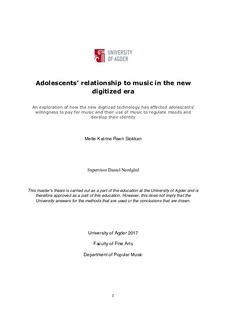| dc.contributor.author | Stokkan, Mette Katrine Raen | |
| dc.date.accessioned | 2017-09-29T09:10:05Z | |
| dc.date.available | 2017-09-29T09:10:05Z | |
| dc.date.issued | 2017 | |
| dc.identifier.uri | http://hdl.handle.net/11250/2457454 | |
| dc.description | Master's thesis Music Management MU501 - University of Agder 2017 | nb_NO |
| dc.description.abstract | This thesis is an exploration of how the technological changes have affected adolescents’ use
of music. The two extended hypotheses I will explore are: “Adolescents today are not willing
to pay for music” and “Adolescents use music to regulate moods and develop their identity”.
The reason for choosing these exact hypotheses is an assumption that the digitization of music
has led to a decreased willingness to pay for access, while the more abstract use of music in
mood regulation and identification is still the same.
To explore my hypothesis I conducted two quantitative surveys among adolescents aged 12-
13. I present the results through descriptive figures and tables, in addition to correlate some
variables of specific interest. Due to the relatively low number of respondents and a lack of
spread in age and geography my surveys can not plead to be statistically representative for
adolescents in Norway. In this respect my surveys can be said to be case studies. Nevertheless
my findings may carefully be used to illuminate some trends in the society.
The results show that in my groups of respondents it is quite common to pay for music,
mostly through paying for access through streaming services. One interesting observation is
that it seems like the adolescents are not aware that they are paying, maybe because the
payment happens through their parents’ credit cards.
Unawareness seems to be a core word regarding use of music in mood regulation as well,
generally they were neither agreeing nor disagreeing that they used music in this regard.
Most of the respondents were neither agreeing nor disagreeing that they listened to the same
music as their friends. This was also the general response when they were asked if they
listened to different music than others they knew. Their response indicates that the
respondents did not consciously use music to identify themselves inside or outside a group.
The respondents did not seem to agree much to the claim that the music they listened to did
tell something about who they were either, but there was a clear correlation between the
degree to which respondents listened to different music than others they knew and how much
they experienced music as a personal identifier. When discussing my results I point to todays’
hit-based distribution of music as a possible explanation for a decrease in identification
through music | nb_NO |
| dc.language.iso | eng | nb_NO |
| dc.publisher | Universitetet i Agder ; University of Agder | nb_NO |
| dc.rights | Attribution-NonCommercial-NoDerivatives 4.0 Internasjonal | * |
| dc.rights.uri | http://creativecommons.org/licenses/by-nc-nd/4.0/deed.no | * |
| dc.subject | MU501 | nb_NO |
| dc.title | Adolescents’ relationship to music in the new digitized era : An exploration of how the new digitized technology has affected adolescents’ willingness to pay for music and their use of music to regulate moods and develop their identity | nb_NO |
| dc.type | Master thesis | nb_NO |
| dc.subject.nsi | VDP::Samfunnsvitenskap: 200::Sosiologi: 220 | nb_NO |
| dc.source.pagenumber | VIII, 73 p. | nb_NO |

